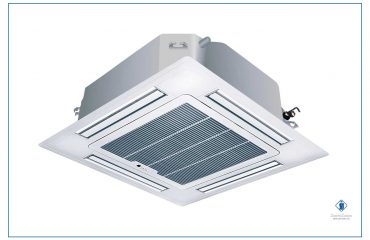VRF stands for Variable Refrigerant Flow and is a component of the air conditioning system, also known as variable refrigerant volume or VFV.
What is a VRF system and what are its features?
The technology used in the VRF system allows users to use it as both a heating and cooling device. As with mini-split units, the refrigerant inside the VRF system is reached by the condensing unit to the desired condition with the desired quality and then by the indoor units; It goes to other parts of the building without the need for canalization and circulates among all parts.
Unlike standard units with zero and one performance, VRF systems use variable speed motors and variable refrigerant currents. They use inverter compressors that consume less energy and can provide partial heating or cooling loads.
The advantage of variable speed motors in VRF systems is that they use less energy. This method will typically consume 30 to 40 percent less energy. Sometimes this energy-saving will save up to 55% on air conditioning costs. Such savings lead to a quick return on investment.
Also, in this system, several indoor units are placed in the same main flow of refrigerant, and the modular design allows the system to grow and expand.
In addition, VRF systems allow users to individually control the amount of cold or heat in each room or area; Or in some units to be able to control both cold and heat at the same time.

How does VRF work?
After switching on, the fully automatic VRF system measures the desired room temperature and measures it with the temperature of the outside space. It then operates and operates the compressor exactly at the desired level.
First, the refrigerant leaves the outdoor unit and moves inside the indoor units that branch off from the outdoor unit and then enters the coils. There is another cycle and it is for the air in the device that circulates between the device and the space inside the room. This air, which is the air inside the room and then enters the indoor unit, passes through hot or cold coils and will enter the room again after reaching the desired and desired temperature.
From this perspective, the internal structure of the VRF system can be considered as fan coils, with the difference that inside the coils instead of refrigerant water is circulating.
When another indoor unit is turned on, the outdoor unit recalculates the needs of all indoor units and increases the compressor load as needed. The ability of the VRF system to regulate external conditions is to control its energy consumption and make it superior to older water systems and chillers and fan coils.
A typical system consists of at least one outdoor unit, a large number of indoor units, refrigerant pumps, compressors, valves, converters, and wires and fittings. Each indoor unit has its own independent thermostat and is controlled by its own wire panel, and some systems also offer a wireless control system or central controls to be able to control all indoor units from a single point.
Outdoor units, which are one for each system, are lightweight and take up little space. This provides an opportunity for outdoor units to be installed on the roofs of buildings without the need to install additional ancillary structures.
In which buildings is the VRF system used?
As with any air conditioning system, the VRF system is used to regulate humidity, air temperature, air circulation and purification.
This type of air conditioning system is suitable for practically any building with any form of use. Residential, office and commercial buildings can use the VRF system to ventilate and regulate their air quality. But the limitation in its application is related to the height of the buildings. Because the distance between indoor and outdoor units should not be more than the limit set by the manufacturer.
Historic buildings, schools, banks, hotels, residential facilities, offices and commercial buildings usually use this system.

 English
English  فارسی
فارسی 



